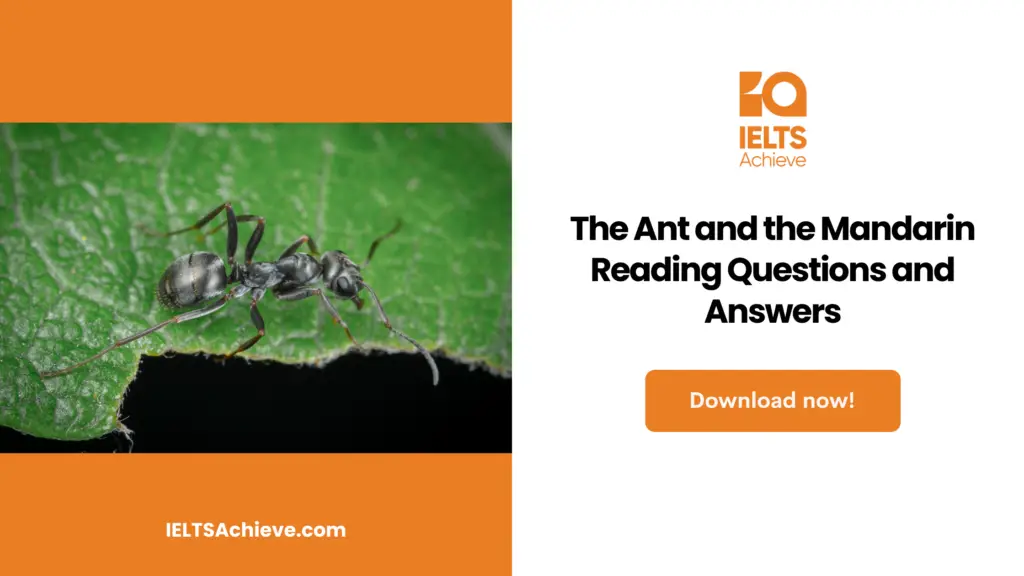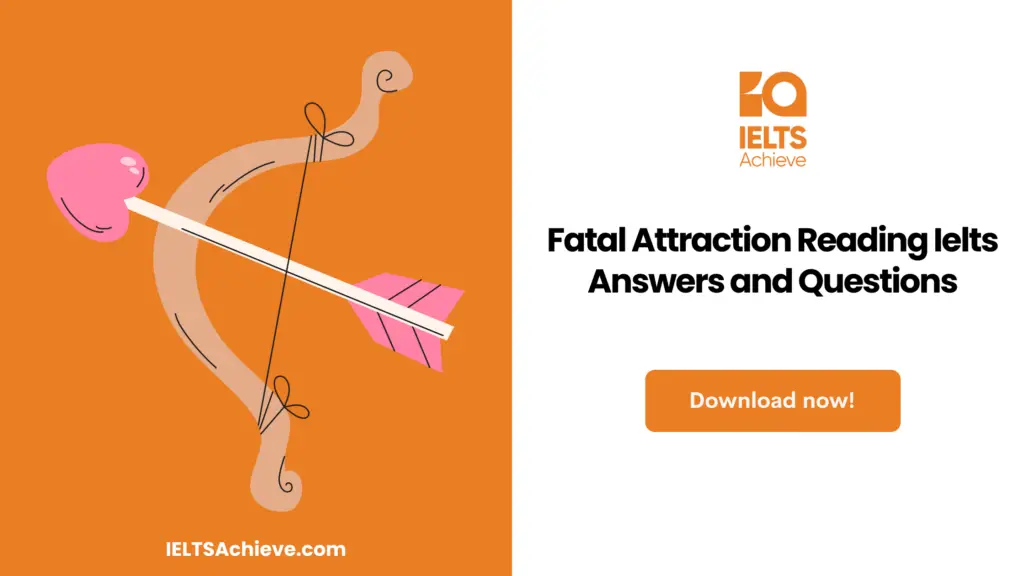The Blog post contains the following IELTS Reading Questions:
- IELTS Reading Matching Features
- IELTS Reading True False Not Given
- IELTS Reading Multiple Choice Questions
Stay informed and prepared for success – Explore our comprehensive Reading Test Info page to get valuable insights, exam format details, and expert tips for mastering the IELTS Reading section.
The Ant and the Mandarin Reading Passage

The Ant and the Mandarin
In 1476, farmers in Berne, Switzerland, had to decide how to stop cutworms from destroying their crops. They sued the bugs. The archbishop held a trial, determined the worms were guilty, and excommunicated them. Chinese farmers took a more pragmatic approach to pest management. They believed that the frogs, ducks, and ants would help them out rather than God. Paddies were stocked with frogs and ducks to help control pests like mosquitoes and the rare swarm of locusts. It was an ant, however, that first suggested the use of biological methods to manage pest populations. In particular, it all began with the yellow citrus ant, Oeco-phylla smaragdina, a predator that has been eliminating pests in the orange fields of southern China for at least 1,700 years. The weaver ant family includes the yellow citrus ant, whose nest is a tidy, tent-like structure made of twigs and leaves bound together with silk. Initially, farmers would make due with improvised solutions, such as ants’ nests. But, increasing demand quickly spawned a lucrative commerce in nests and a novel form of agriculture: ant farming.
Yellow citrus ants are surprisingly well-liked for being a type of bug that can cause bites. The Oecophylla smaragdina ant is a terrifying predator even by ant standards. It’s large, quick, and packs a severe nip that can kill many of the pest insects that otherwise feast on the orange trees in Guangdong and Guangxi, southern China. Chinese orange farmers have used these six-legged killing devices for at least 17 centuries to protect their orchards from pests.
In the Far East, citrus fruits originated, and the Chinese were among the first to appreciate their delicious flesh. Oranges, lemons,and pomelos all trace their origins back to China, yet the country also boasts the widest variety of citrus pests. In addition, black ants, sap-sucking mealy bugs, and leaf-devouring caterpillars are just some of the plant-eating insects that are attracted to mandarin (or kan) trees, which produce the tastiest fruits. Given the prevalence of predators, it stands to reason that fruit farmers would employ some sort of defence to save their crops.
It wasn’t until 1 the early 20th century that Westerners learned about the secret weapon used by Chinese orange growers. Citrus canker was ravaging Florida in 1915, so the US Department of Agriculture sent plant scientist Walter Swingle there in quest of disease-resistant orange cultivars. During his time spent researching the citrus groves outside Guangzhou, Swingle stumbled across the legend of the cultivated ant. He was told that these ants were “produced” in a nearby village and sold to orange farmers by the nest.
Hsi Han’s AD 304 treatise on tropical and subtropical botany contains the oldest record of citrus ants at work among orange trees.”People in Chiao-Chih sell ants in bags made of rush matting, which they take to the city’s markets. The nests are as smooth as silk. I ants are for sale in the bags, which are fastened to twigs and leaves. These ants are larger and more of a reddish-yellow colour than the average black ant. Without this species of ant, many dangerous insects will eat away at the fruits on southern kan trees, resulting in imperfect fruit for everyone.”
Farmers originally relied on nests they found in the wild or purchased in the market, where a bustling commerce in nests occurred. “In the southern part, it is observed that orange trees that have been treated for ants are said to produce wormy fruit.” So everyone is in a hurry to go out and acquire orange tree nests “Around around 890, Liu Hsun noted several “Strange Phenomena” in the South.
The level of sophistication in the company rose rapidly. Beginning in the 10th century, rural residents began luring ants into man-made nests with fatty treats. According to a 1130 essay by Chuang Chi-Yu, “fruit-growing families buy these ants from vendors who make a profession out of gathering and selling such critters.” “To catch them, they stuff the cavities of hog or sheep bladders with fat and set them adjacent to ant hills. Once the ants have made their way into the bladders, that’s when they remove them. This technique is commonly known as “orange ant farming”.Farmers stapled the bladders to trees, and the ants soon spread to neighbouring trees and set up permanent colonies.
To hasten the colonisation of their orchards, producers in the 17th century began constructing bamboo corridors between the trees.Along these thin connections between trees, ants “by the hundreds of thousands” construct nests. How successful was it? Evidently, the orange farmers agreed. Keep the fruit trees free of insect pests, especially caterpillars, as recommended by Chhii Ta-Chun, an authority who wrote about the topic in 1700. To prevent harm to the trees, their eradication is required. The efficiency of human labour pales in comparison to that of ant power.
Like everyone there, Swingle was blown away. Yet, many Western biologists were sceptical of his reports. This was a novel and controversial concept in the West: utilising one insect to kill another. In 1888, the Australian vedalia beetle had been the first to make a significant contribution, preventing the complete collapse of California’s nascent orange sector. The state’s citrus crops were in danger, and only this beetle had managed to make any in- T roads into the outbreak of cottony cushion scale. Swingle had learned that California’s “first” was actually nothing of the sort. For generations, the Chinese had perfected the art of biological control.
It wasn’t until the introduction of potent organic insecticides in the 1950s and 1960s that the long tradition of ants in Chinese orchards began to dwindle. Yet, some farmers still used ants as a pest control method despite the widespread adoption of chemical alternatives. Those who gave up on ants in favour of pesticides soon discovered their mistake. Growers began reviving the ancient ant patrols in the late 1960s in response to rising expenses and pests developing tolerance to the chemicals. Their faith in their insect labour force was well-founded.
As long as there were enough ants in the trees, studies conducted in the early 1960s indicated, they were quite effective at eradicating some pests, particularly the larger insects. Around twenty percent more robust leaves were produced by trees infested with yellow ants compared to those without. Recent tests have proven that these trees produce the same amount of fruit as those treated with costly chemical sprays.
The lack of effectiveness of citrus ants in preventing mealybugs, waxy-coated scale insects that can cause significant damage to fruit trees and one of the main grounds for initial scepticism by Western experts, is an apparent disadvantage of utilising ants. Actually, the mealybugs are protected by the ants in exchange for the pleasant honey-dew they produce.
There was never any evidence to suggest otherwise from the orange growers, but Western scientists were sure they knew better.
The results of studies conducted in the 1980s demonstrate that the farmers were correct. The harmful effects of X mealy bugs are mitigated in areas where they thrive thanks to heavy parasitism by ants.
Carnivorous ants, as opposed to harmful chemicals, help orange farmers keep the natural balance of their plantations. While ants take care of the larger pests, other predatory species keep the numbers of lesser pests like scale insects and aphids under check. When compared to the long-term effects of drugs and social isolation, ants are clearly preferable.
Unlock your full potential in the IELTS Reading section – Visit our IELTS Reading Practice Question Answer page now!
Recommended Questions:
Renewable Energy IELTS Reading Question with Answer
The Ant and the Mandarin IELTS Reading Questions
Questions 1-5
Take a look at the timeline below and the answers to Questions 1-5. Using the given times A-G, pair the appropriate events with them.
- One of the first descriptions of citrus ants appears in a marketplace.
- Swingle visited Asia for academic purposes.
- In the West, humans use the discovery of one pest insect as a launch pad to combat others.
- Instead of using citrus ants, Chinese fruit farmers have begun using pesticides.
- A minority of Chinese farmers have turned back to the age-old bio-method.
| List of Dates 1888 AD 890 AD 304 1950s 1960s 1915 1130 |
Improve your performance in Matching Features questions by clicking here to access our comprehensive guide. Learn how to match specific features or characteristics with the options provided in the IELTS Reading section.
Questions 6-11
Is each of the following in keeping with what you learned in the Reading Passage? Write
TRUE if the statement agrees with the information
FALSE if the statement contradicts the information
NOT GIVEN if there is no information on this
6. The number of citrus pests in China is greater than in any other country.
7. Swingle travelled to China in a bid to bring a bug back to the United States.
8. Swingle’s discovery was incredibly impressive to a lot of people.
9. The price of pesticides rose, which was a problem for Chinese farmers.
10. Farmers in China have stopped using pesticides.
11. More leaves fell from trees that had ants than from trees that didn’t.
Enhance your skills in identifying information as True, False, or Not Given. Click here to discover expert strategies and techniques for mastering this question type in the IELTS Reading section.
Questions 12 and 13
Pick the right answer from the choices a, b, c, or d .Fill out boxes 12 and 13 on your answer sheet.
12. The Oeco-phylla smaragdina, a species of yellow citrus ant, has been cleaning off pests in the orange fields in which part of China?
- Southern China.
- Guangzhou
- West China.
- Far East China.
13. When compared to trees that do not have what can produce about 20% more leafy growth
- vedalia beetle
- mealy bugs
- yellow ants
- caterpillars.
Ready to improve your performance in Multiple Choice Questions (MCQs)? Click here to access our comprehensive guide on how to tackle MCQs effectively in the IELTS Reading section.
Unlock your full potential in the IELTS Reading section – Visit our IELTS Reading Practice Question Answer page now!
Recommended Questions:
Renewable Energy IELTS Reading Question with Answer
The Ant and the Mandarin reading answers
1. C
2. F
3. A
4. D
5. E
6. True
7. False
8. False
9. True
10. True
11.False
12. a
13. c

We hope you found this post useful in helping you to study for the IELTS Test. If you have any questions please let us know in the comments below or on the Facebook page.
The best way to keep up to date with posts like this is to like us on Facebook, then follow us on Instagram and Pinterest. If you need help preparing for the IELTS Test, join the IELTS Achieve Academy and see how we can assist you to achieve your desired band score. We offer an essay correction service, mock exams and online courses.

